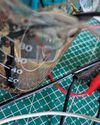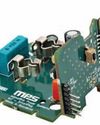Op-Amp-Based VEHICLE THEFT DETECTOR
Electronics For You
|January 2025
A simple, low-cost device can effectively alert homeowners or occupants if a parked vehicle is moved or tampered with.

This hardwired detector features a main circuit with a buzzer alarm installed inside the house, while a sensor is mounted on the vehicle being protected.
The sensor should be positioned on the vehicle in a location shielded from heat, rainwater, dust, and dirt. Its leads must be routed to an accessible point outside the vehicle for easy connection to the wires coming from the main circuit.
For consistent protection, the sensor leads must remain connected to the main circuit whenever the vehicle is parked. Any disconnection, cutting, or shorting of the wires triggers the alarm and activates the LED indicator. The detector is powered by an external 12V DC adaptor, with a 9V dry cell providing backup during power failures. Fig. 1 displays the author’s prototype of the detector.
Circuit and working
Fig. 2 shows the circuit diagram of the vehicle theft detector. The system is built around quad op-amp LM324 (IC1), quad 2-input NAND gate IC 7400 (IC2), and a few other components.
The quad op-amp IC LM324 (IC1) functions as a voltage comparator. The IC1A comparator detects higher voltage output from the sensor (in the dotted box) when the connecting wires (between TP1 and TP2) are short-circuited or connected while someone attempts to tamper with the vehicle.
This story is from the January 2025 edition of Electronics For You.
Subscribe to Magzter GOLD to access thousands of curated premium stories, and 10,000+ magazines and newspapers.
Already a subscriber? Sign In
MORE STORIES FROM Electronics For You

Electronics For You
Tech Majors Are Racing TOWARDS NET-ZERO - What About You?
Apple, Microsoft, Amazon, Google, Infosys, Wipro—global and Indian firms are heading closer to achieving net-zero emissions, a mandate to combat climate change. Here is what you need to know to start your journey...
12 mins
December 2025

Electronics For You
Miniature IoT WATER TDS And LEVEL MONITOR Cum CONTROLLER
For setups that rely on stored water, clear awareness of tank level and water quality is essential.
3 mins
December 2025

Electronics For You
The Impact Of GENERATIVE AI On The Future Of AUTOMOTIVE AND EVs
Autonomous vehicles, connected ecosystems, and smart factories are only the beginning. Generative Al is pushing the auto industry beyond predictions into a bold era of creativity-from EV design to real-time diagnostics and showroom automation. Here is how GenAl is reshaping innovation across the automotive value chain.
8 mins
December 2025

Electronics For You
How AI Tools Are Making SOFTWARE DEVELOPMENT BETTER
AI is reshaping how we code, debug, and collaborate. From Copilot to automation, it is changing software development in ways worth exploring.
3 mins
December 2025
Electronics For You
How AI Tools Are Making SOFTWARE DEVELOPMENT BETTER
AI is reshaping how we code, debug, and collaborate. From Copilot to automation, it is changing software development in ways worth exploring.
3 mins
December 2025

Electronics For You
5 Interesting Reference Designs FOR SMART HOMES
Smart home devices are transforming the way people interact with their appliances. They make homes more convenient, secure, and energy-efficient. From smart plugs and energy monitors to smart locks and thermostats, reference designs help design engineers create connected products that are easy to use, consume less power, and are reliable. These designs allow you to control devices remotely, track energy use, extend battery life, and automate routines. They provide practical solutions for upgrading homes and small commercial spaces without major modifications.
3 mins
December 2025

Electronics For You
Fancy USB LED VASE
This USB LED vase is a simple yet elegant device that fuses art with electronics to create a decorative lighting display. Powered directly from a standard USB port, it uses readily available components such as MOSFETs, resistors, capacitors, and LEDs to produce a striking, dynamic sequence of lights.
3 mins
December 2025

Electronics For You
"WHAT OTHERS SELL IN FOUR BOXES WE BUILT IN ONE"
Years of custom field work are shaping a product line with its own cloud, its own hardware, and a market that is now beginning to recognise its value.
8 mins
December 2025

Electronics For You
BUILD LARGE LANGUAGE MODELS
Large language models are machine learning models designed for a range of language-related tasks such as text generation and translation. Here’s how open source software can help you build your own large language model.
6 mins
December 2025

Electronics For You
Rare Earth Or Rare Ingenuity? India Remains Between The Two
With China firmly controlling rare earth exports, India confronts a critical moment in its technological trajectory.
8 mins
December 2025
Listen
Translate
Change font size

